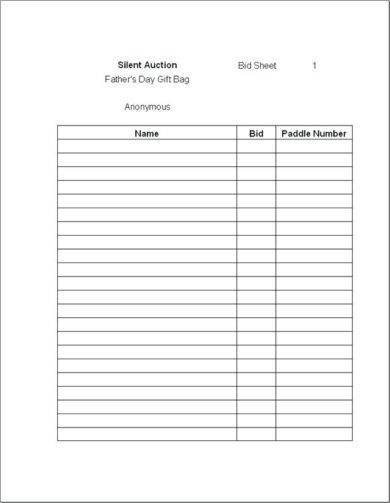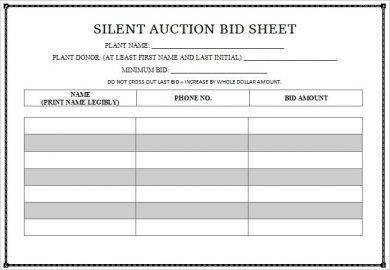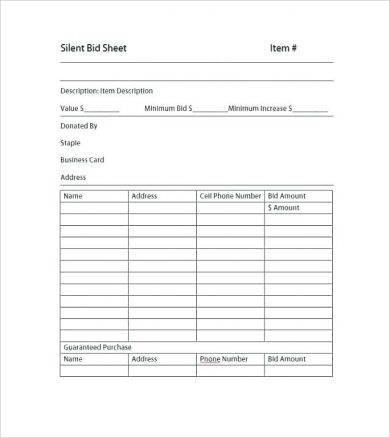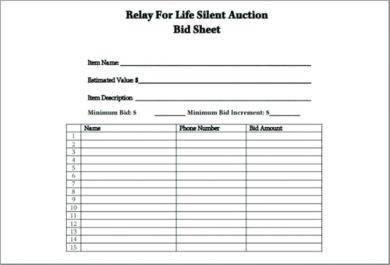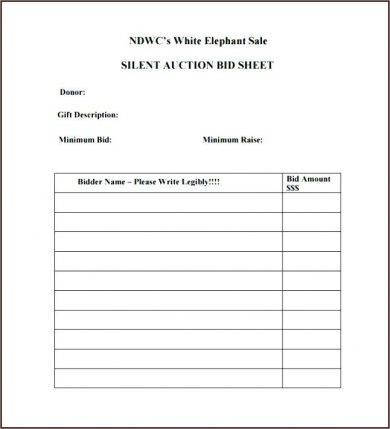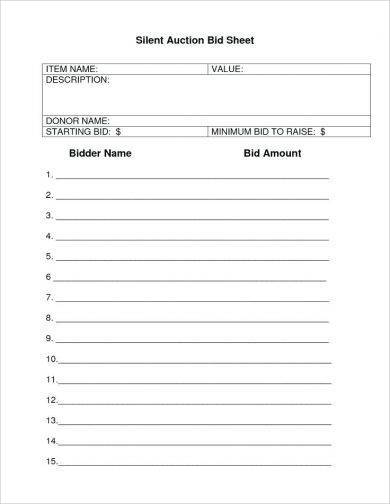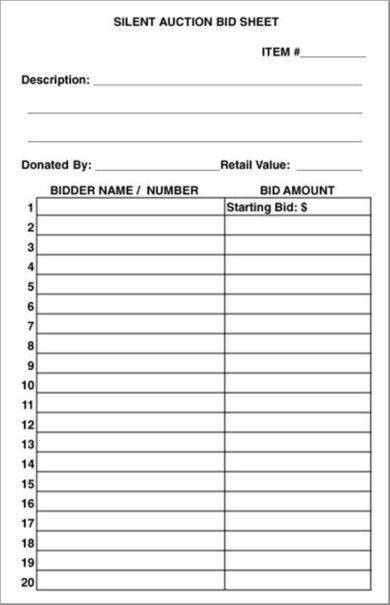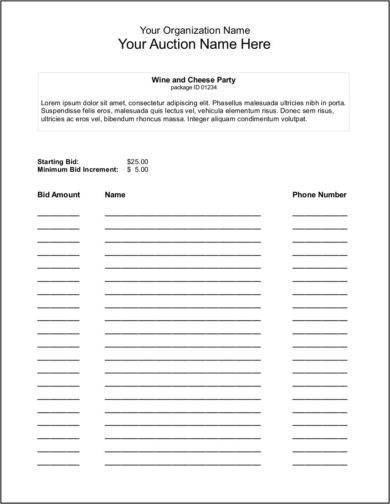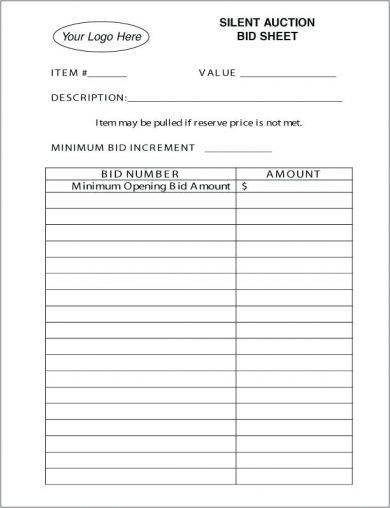11+ Silent Auction Bid Forms Examples to Download
Auctions are a great place to find rare and valuable antiques that were once owned or made by a famous artist, celebrity, politician, or royalty. The items available at the auction are usually sold for a reasonable price, where the proceeds then serve as a donation to a nonprofit program or a charity fund. You may also see auction bid form examples.
There are several types of auctions, one of which includes the silent auction. But unlike traditional auctions, silent auctions are done a bit differently. Read on to find out more about how silent auctions are conducted. You may also like freelance proposal examples.
Silent Auction Bid Sheet Example
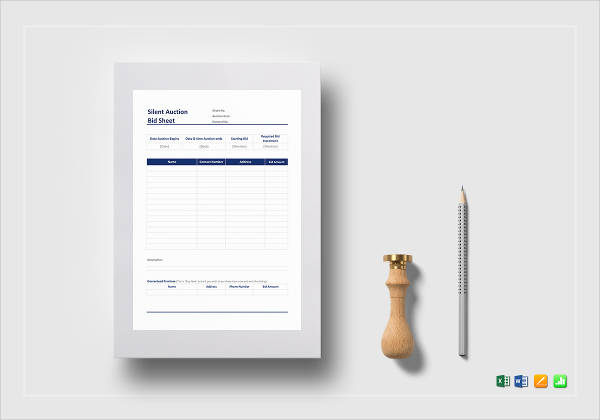
Simple Silent Auction Bid Sheet
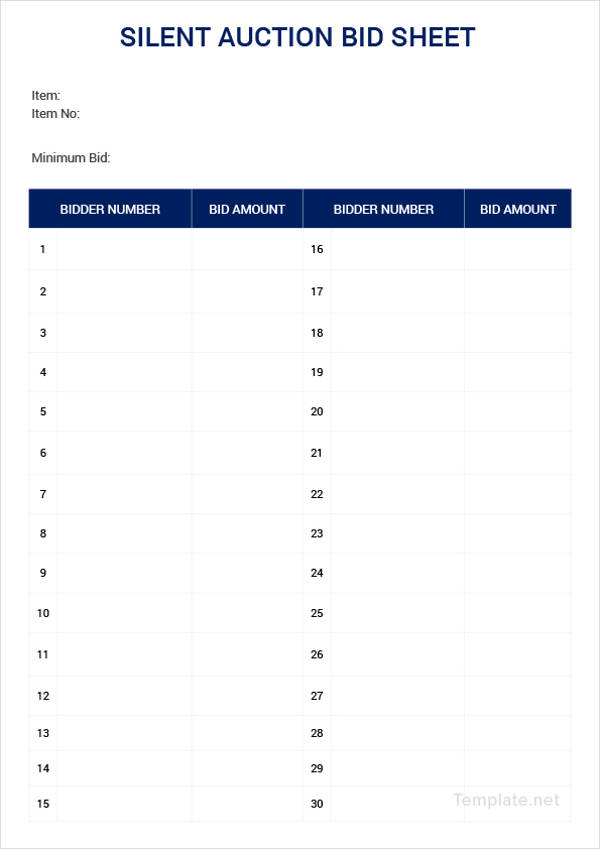
Basic Silent Auction Bid Form Example
What You Need to Know about Silent Auctions
If you’re looking for a new annual campaign for your nonprofit organization, then a silent auction would be an excellent choice.
A silent auction is slightly different from a regular auction in a sense that attendees are not always aware of the current high bid. Though an auctioneer may be present at the event, he isn’t there to call out the highest bid amount on a particular item or to close the bids once bidders stop bidding. You may also check out proposal templates and examples.
Instead, bidding is done privately through forms or sheets of paper that are being set up at individual tables. This allows attendees to bid on multiple items at once. After which, the written bids are then examined, and the person who bids the highest for each item should pay and claim the item that was granted to them. You might be interested in task sheet examples.
Take note that silent auctions happen silently. Here, each item auctioned at the event is listed in bid sheet or form that is dedicated to a specific category. In cases where clipboards are handed out individually, attendees of the event are unaware of other bid amounts. If guests are asked to write on a shared bid form at an auction table, numbers are assigned to represent each bidder and to maintain anonymity.
Silent auctions can be an exciting event that often result in higher bids because of how bidders may keep their identities hidden when placing in a bid.
Blank Silent Auction Bid Form Example
Detailed Silent Auction Bid Form Example
Editable Silent Auction Bid Form Example
NDWC’s Silent Auction Bid Form Example
How to Organize a Silent Auction
A silent auction is a highly engaging activity that entails the active participation of guests attending the event. This can keep donors fully immersed in both the event and the cause.
However, silent auctions can also be more difficult to plan as opposed to other auction events. This is because the event can be slightly more complicated than the traditional method, forcing organizers to pay close attention to every detail and rule to be implemented for the actual event. If planned correctly, your organization may host a successful fundraiser with ease. You may also see landscaping proposal examples.
1. Identify your goals and budget.
Before anything else, determine a goal and a budget to focus on. The last thing you would want is to invest more than you’re going to raise from it.
When setting your goals, make sure to consider the needs of your campaign. Where will the money go? Who will benefit from it? The time, effort, and money put into the silent auction would only be worth it if you can raise enough funds to meet your overall campaign goals.
2. Gather an auction team.
There are numerous facets involved in a charity auction, such as the planning, organizing, and setup stages that require a powerful team of dedicated members to put together.
To mention a few key players in the game, you’ll need to recruit an auction chair, a planning team, a procurement team (to solicit event items), a theme chair, an emcee, auction monitors, and general volunteers to assist in covering the entire event. You may also see request for proposal examples.
Fortunately, most of these rules may be filled by members of your staff and random volunteers. You just need to make sure you have enough people on board to complete all the necessary tasks before the said event.
3. Procure the auction items.
Ensure that the items sold at the auction are of value to your target audience. You shouldn’t blindly ask for or accept any type of donation that attendees might not be interested in; instead, you must keep an eye on every item that comes your way. You may also like cleaning proposal examples.
Items that are likely to generate the most bids tend to possess three distinctive qualities: appeal, uniqueness, and a reasonable price. Make sure your procurement team is properly briefed regarding the items to be auctioned off at the event, including a list of appropriate items, among others. That way, they can stay focused in the most beneficial way possible. You may also check out proposal letter examples.
4. Find a venue.
Since auctions are usually planned many months in advance, you must set a desired date and book a venue. Booking early will give you enough time to prepare and make changes before the last minute. Most nonprofits hold their auctions at art museums, school gymnasiums, and even golf courses. You might be interested in business proposal examples.
Ultimately, the type of venue you choose would depend on the space, accessibility, connectivity, and ambiance of the location.
5. Market the items and the event.
Like any other event, promotional efforts play a huge role in its success. Begin advertising your auction a few months before the actual day to ensure a healthy turnout. You can use social media marketing for a more advanced approach, or stick to the conventional event flyers and posters for a targeted reach.
6. Formulate a bidding method.
There are two ways to carry out the bidding: through bid forms or through mobile bidding. In the first method, guests are required to fill out an auction bid form with their name, bidder number, and bid amount next to the item they hope to acquire. Modern bidding, on the other hand, is a more advanced approach that requires the use of a smartphone and an auction software to carry out.
Both bidding methods are advantageous in their own ways, so choose the method that is most suitable to your event along with the resources available.
7. Host the event!
Once the event has been planned, it’s time to put everything into place. Your committee must arrive as early as possible to set up each station and create your displays. There must be a designated area for your registration and checkout tables, along with visitor IDs for guests to wear. Items along with their respective title and description cards must also be made visible for public viewing. You may also see tender notice examples.
Make sure that the merchandise booths, donation booths, and assistance booths are easy to locate for the convenience of each guest.
Silent Auction Bid Form Example
Silent Auction Bid Form Format Example
Silent Auction Bid Form Sample
Silent Auction Bid Form Template
Simple Silent Auction Bid Form Example
Guidelines for Improving Your Silent Auction Bid Forms
When conducting a silent auction, you need to make sure your bid forms are easy to use. As a primary tool for the event, there are a few essential information to include in the form.
1. Organization Name
The bid form must be labeled with your organization’s name and logo design. This will remind donors that they’re not just purchasing an item, but they’re also supporting an important cause with each of their bid. You can even include a brief text indicating where the funds garnered from the event will go to.
2. Item Tracking Number
The tracking number will be used for both the buyer and the auction committee to refer to during checkout. This can also come in handy when recording the winning bids.
3. Title & Description
Item titles need to be compelling enough to attract bidders. It should be made big, bold, and clear for guests to remember later on. You must also include a brief description regarding the auction item.
Relevant details like what the item is and where it came from should stated in the description, along with other restrictions such as expiration dates and price caps. If it’s impossible to include everything on a single page, you may utilize a separate display sheet. You may also see free proposal examples.
4. Donor Recognition
It’s always a good idea to acknowledge the entities responsible for donating each auction item for the event. And who knows, the added recognition might even help you secure possible donations from them in the near future. You may also like services proposal examples.
5. Starting Bid and Minimum Bid Increments
If you don’t want a rare painting by a famous artist like Leonard Da Vinci to be given away for a measly $15, always start with a fair bidding amount. A minimum bid increment will also help encourage people to make a generous bidding for each auction item. You may also check out sheet examples.
6. Limited Bidding Rows
Empty bidding forms do not lead to more bidding, neither do bid forms with numerous rows. To stay on the safe side, 12–15 bidding rows would do.
7. “Buy Now” Option
If you have any high value or highly desirable auction items available at your event, then you might want to consider adding a “Buy Now” option for each category.
Any bid added to the said section would stop all other bids and become the winning bid amount. The amount you choose should be the amount you’d be happy to receive; otherwise, you could be giving away a valuable item for an amount that’s lesser than what other bidders would have proposed. You might be interested in security proposal examples.
Silent auctions are a creative yet thrilling means to raise funds for a charity program for your nonprofit organization. Though it may demand a bit more time and energy to conduct as opposed to the regular type of auction, if planned and executed correctly, the auction event is sure to receive an impressive turnout to help your cause!



